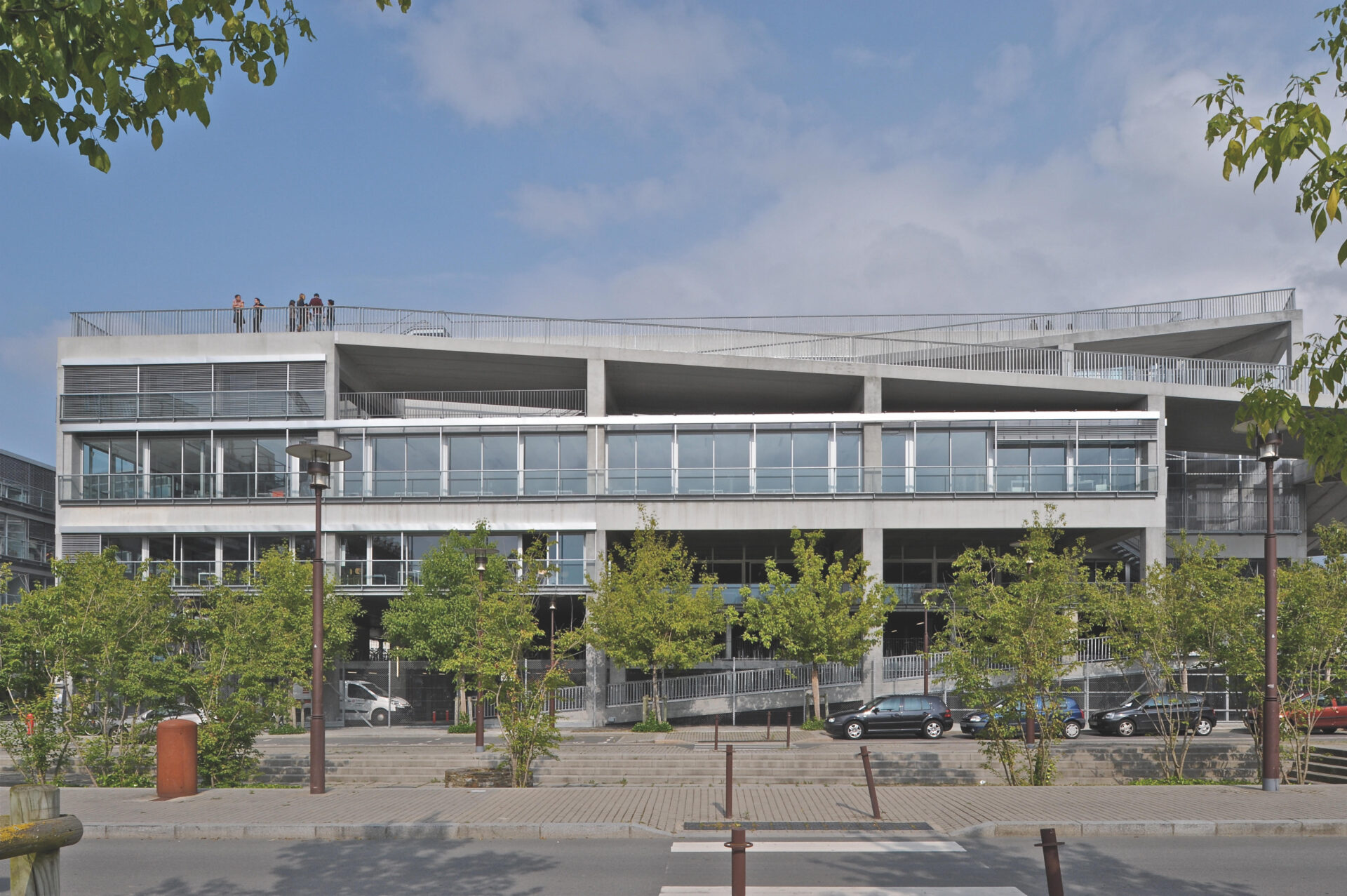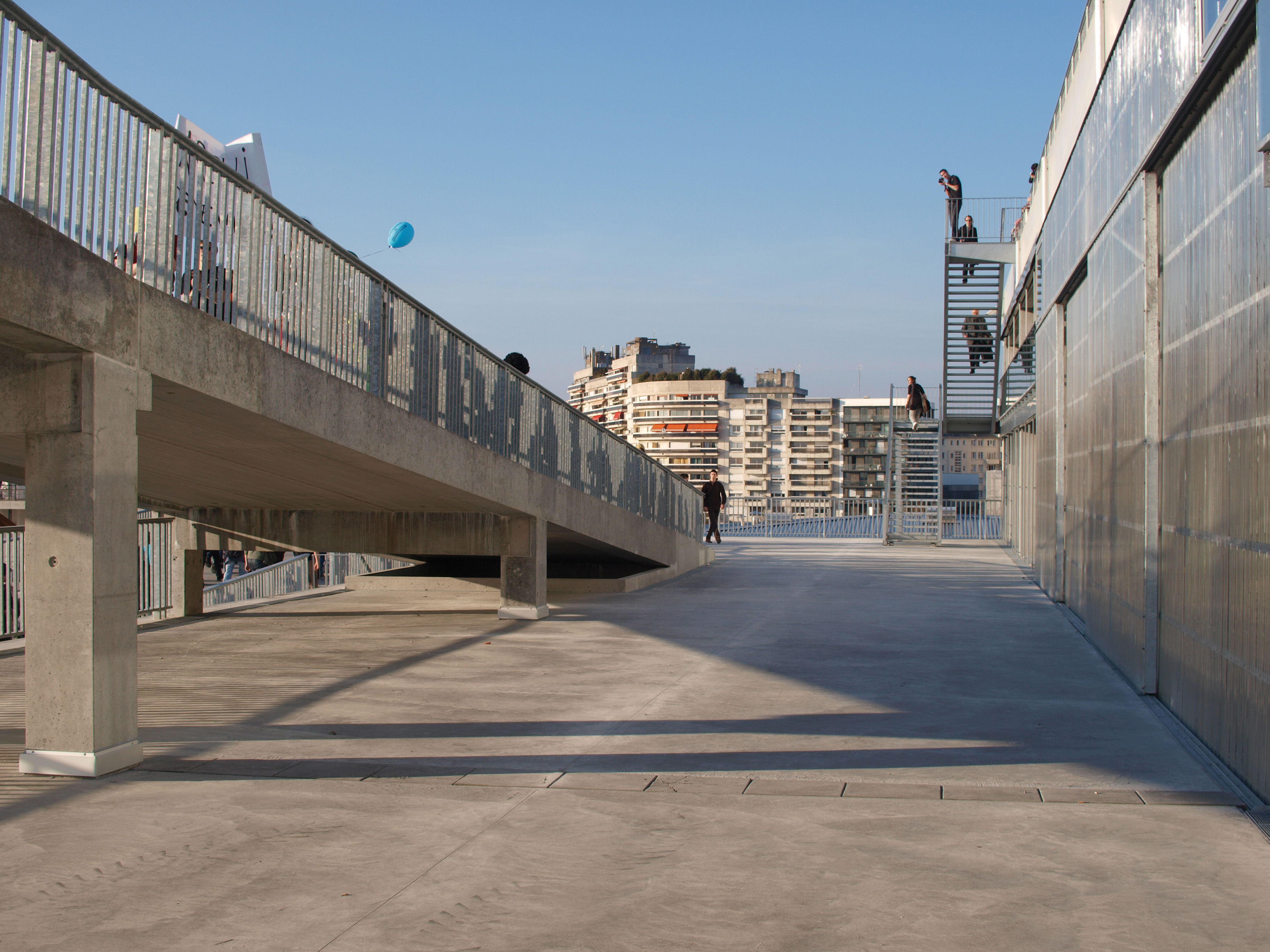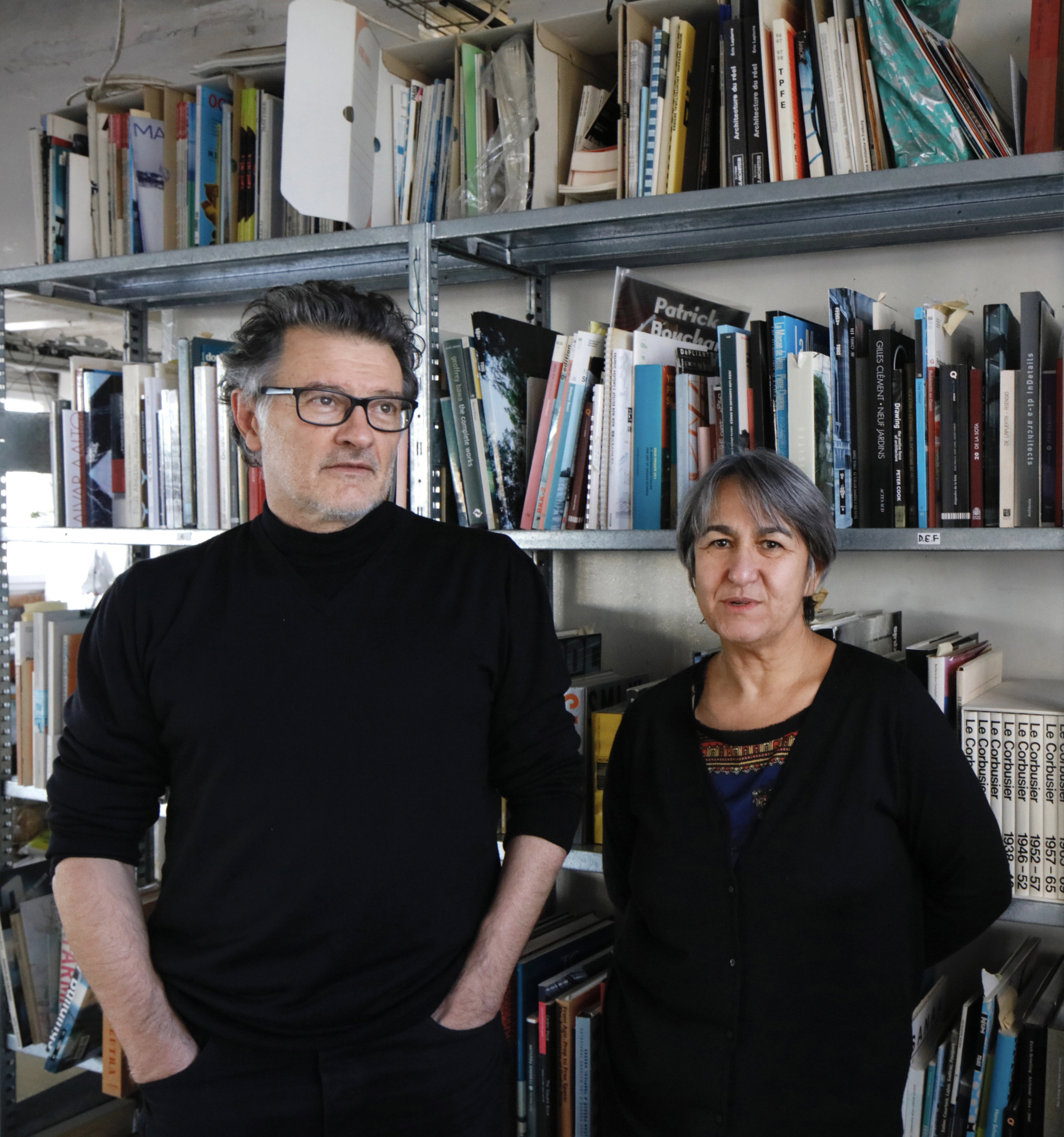
Going beyond the Program
Anne Lacaton and Jean-Philippe Vassal (L&V) in Conversation with Karine Dana (KD)Anne Lacaton and Jean-Philippe Vassal designed the Nantes School of Architecture in 2009. In this interview, they look back on this decisive experience during which the concept of “free space” was considerably expanded, opening opportunities for completely new educational exploration.
KD: What are the specifics of an architecture school program, and could you reminisce on the genesis of this project?
L&V: Nowhere is there more knowledge, information, and energy about urban planning than in a school of architecture. More is in circulation there than in an urban planning studio, a city hall, or architects’ offices. Sadly, though, there is no sense that these resources are visible, usable, and accessible. It seemed important to us that they should become so.
The thought that the school of architecture should be in the very center of the city of Nantes forced us to go beyond an architecture school program. We had to produce a system for the city. A school of architecture must certainly be part of the city’s system. We wanted passers-by to be able to enter it and get into discussions, for students from other schools to be able to come in easily and critique and assess each other. We wanted these debates, these confrontations to happen.

Working on a school of architecture also raises the question of what to give the students by way of space for experimentation. The fact that we worked on the competition while we were involved in the Palais de Tokyo was important here.
In fact we were experimenting in real time with the grand dimension of spaces and the potential of a space in which you could find almost everything you need without the space being closed. On the contrary, the space could remain very porous both inwardly and in relation to the city: a large plane on which you could stay all day, until midnight, doing very different things, without being cut off from either the outside or the inside. We had undergone an experience of wandering that, with its ambiences, its different heights, its variable lighting and its sequence of spaces of all kinds, took us completely beyond the logic of a building. This learning process infused our thinking on the Nantes School of Architecture. And the idea that what was happening at the Palais de Tokyo could happen in the school also looked interesting. It could be a place where artistic programming or events could create new internal dynamics.
KD: With this point of view, how did you envision the Nantes School of Architecture project and its “overflow” potential?
L&V: One of the main questions we asked ourselves while working on this project was: should we respond strictly to the program, as it is set out, or can we go beyond it?
If one envisages going beyond a program, then that means that some of the built area can become a free space, which is fundamental to the life of a project. And, as we see it, this free space must be generous in order to allow a real transformation: double the size of the surface anticipated from a program. That is always very hard to achieve. The question of going beyond is in fact intimately linked to the questions of the economy and the user’s commitment. It crystallizes many fears. In the minds of many project owners it is impossible to stay within a given budget by going beyond a program. Any program would be inseparably defined by the ratio of surface area to construction cost. Today it is very difficult to escape from this economy/budget/programme system which determines standards and prices per square meter, and which always leads to doing the bare minimum or very little more. This fear of going over budget is a real brake on the possibility of overflowing the program.
And if, in the course of competitions, an expectation of expanding the concept is expressed, one senses that the first hint this triggers is a kind of retreat by the applicants, as if fearing they will not be able to extricate themselves. Moreover, giving this additional space, which equates to surfaces whose function cannot be anticipated, puts users in an unusual situation: they wonder how they can use the unprogrammed spaces linked to the program overreach. And this raises the question of their commitment to do something with this space.
We were able to experiment with this condition of exceeding the program in realizing the Nantes School of Architecture, and also the Cité Manifeste in Mulhouse and the FRAC Nord-Pas De Calais in Dunkirk—three projects for which we doubled the requested surface areas while remaining within the allocated budget. We were certainly accorded a certain amount of trust, which allowed these projects to succeed, but we had to face this very restrictive logic of cost-per-square-meter together with a fixed program budget, and we had to carry conviction. Many possibilities were suggested at the time of the competition for the school, but there were contradictions between the expectations, or the dream of the director and the teachers, who wanted to give freedom through space, and the program of the Ministry of Culture, which was more restrictive and had to be adjusted in relation to the surface areas and the budget. We therefore played with surfaces that did not appear in the ratio of habitable surfaces. The roof—a high square in the sky—and the ground floor—a space under stilts with very little planning—were approached in this sense. Highly connected to the city, these two levels are crucial for the general functioning of the school and act entirely as free spaces.
KD: This question of exceeding the program correlates with the question of structural freedom, or how to build structures in which anything can result …
L&V: To make exceeding the program possible, one must work on surfaces of great potential, and hence from a structure that enables them. For the Nantes School of Architecture, the natural ground is the most “capable” surface. We kept it, with its few defects and its many qualities, and imagined a large roof 24 meters above it, along with an external ramp functioning as a roadway and connecting ground floor to roof terrace, and all the created spaces between the two, with their specific climates and containing classrooms, library, studios, etc.

Our construction plan involved a primary structure of prefabricated concrete columns and high-capacity, high-resistance alveolar floors: 1 tonne per square meter. This was the necessary precondition for the ceilings to function as floors. We created a wide framework, so as to minimize the number of columns and foundation points needed. The system of relationships this superstructure contains generates a very interesting form of vertical urbanism. In terms of capacity, it supports a light metallic secondary structure that fits inside and is easy to assemble and cost-efficient. Thus, by playing on the possibilities of the mezzanine, we have defined plenty of variations of spaces, heated, open, or lit in different degrees. Once this large-capacity framework is assembled, the question arises of the architecture and the way it integrates this space. Just as at the Cité Manifeste in Mulhouse, the homes were slotted in once the structure and the envelope were in place.
Whatever the programs we tackle, we always aim to design structures that are highly expansive, not too limiting, and adaptable, and whose construction elements—networks, façades, partitions—are uncoupled. This quest for structural freedom, which runs through all our projects, is in line with thinking of space as a loft: how to produce the largest imaginable surfaces and volumes, as economically as possible?
Such an objective implies thinking in terms of increasing, of enlarging a central space and giving it more depth than it would generally be allotted. For the Nantes School of Architecture, 60 meters separates the façades, space that we filled, instead of digging it out. While the perimeter and the alignment of the façade are determined by the ground, we take advantage of any extra interior space to produce other sorts of moods.
For the school of architecture in Nantes, we worked to an open plan concept, but also to one of open volume. This goes on to question the notion of standard height. In adopting inter-story heights of seven to ten meters, we asked ourselves what would be the nature of a space that was as flexible and adaptable as possible in its vertical dimension. Increasing height offers very interesting possibilities for redividing a space. In Nantes, heights between levels are divisible into two or three, or are left in their full amplitude. This free volume approach also allows one to consider differing levels of lighting to accord with different functions, and thus to link in a specific way to the façades, just as to the central interior space, where light will penetrate to a greater or lesser extent according to the way the space is partitioned.
To consider exceeding a program is to consider the possibility of different ambiances. We realize that it is this super-dimension and the extra space that allow us to experiment with ambiances and to verify that a program works well.
So the free space began in the design process. We took the liberty of designing this large, functional structure containing a flexible secondary structure. This excess capacity has a lot of advantages, and it allowed us to adapt to evolutions and modifications that occurred in the course of the project, of the construction itself, and after hand-over. Thus, an extra thousand-square-meter workshop was added at ground-floor level in place of parking space, as also were an amphitheater and a huge digital model-making machine shared with the École Centrale.

KD: How have the uses of these free spaces evolved?
L&V: The Nantes School of Architecture has operated for ten years now, and what has been done there is extremely varied. Everything is possible. The school which encompassed three associations at its opening, today shelters seventeen, of very varied status. All of them have a great deal to offer. The amphitheater, being open to the city, offers interesting possibilities for interaction to it as well. Looking back, one can see that the school’s users quickly seized on these additional spaces, something we had already seen in housing spaces we have created, from the Latapie house to the Cité Manifeste, or, later, the 500 housing units of the Grand Parc in Bordeaux.
Going beyond the program allows us to multiply the number of projected uses. Thus, the school’s traditional classrooms, the project studio, and the model workshop do not function in isolation. All are interconnected; the spaces control and respond to each other. So it is possible to hold a class in the studio and do experiments right next door, or to put on a performance in the studio while holding classes in the open space, and so on. This state of affairs prompts extensions of use, projects within the project. On the other hand, these free spaces are actual spaces. They are identifiable by their luminosity and their ventilation, more or less necessary. These qualities of atmosphere favor different activities.
While included in the spaces of circulation, these spaces of undefined use, being very expansive, become much more than that while yet remaining spaces of circulation. This double property is very interesting. Free spaces are spaces of circulation morphing into spaces of use, spaces for teaching, for performance, for experimentation: fundamentally different pedagogical spaces. This characteristic encourages invention. From the moment a circulation space is upsized, other things can happen there, and this causes the adjoining functional spaces to react. It is a double space, endowed with a certain mobility. If one had to look for an analogy with daily life, one could compare such a space with a living room. Classrooms monofunction as “rooms,” but the free space becomes a living room: a space of incentive, of comment, of interaction. This is what is interesting. But in the program itself such space does not exist; there are only “rooms.” A program will never require students to sit on the floor somewhere and talk … Likewise, the possibility of shows, sports, yoga, cinema or dance, was not provided for in the program. A program never envisions unprogrammed spaces.
The evolution of the Nantes School of Architecture in is in line with the project, but the users must be alert and ensure that the free space is not permanently filled. That is the difficulty. These additional spaces are not undifferentiated spaces but must remain in circulation and occupiable, able to be filled but also emptied in order to maintain a relationship of balance and interconnection with adjoining spaces. Particular vigilance is needed over these free spaces because, if all are occupied, the project no longer functions. And this implies that the users need to discuss the sharing of their use.

KD: How come one does not feel one is in a “building” when moving around inside this school?
L&V: As in a large loft, there is no fear of breaking anything in the Nantes School of Architecture. Everything is solid. Everything is available. And one is in permanent contact with the outside space. You walk as if you were outside. You feel you can appropriate the space, because its size, its height do not refer to anything. We are never in “rooms.” All these things together create the feeling that one is not in a building but in a landscape. When we contemplate the library, we do not feel we are faced with a room inside a building but outside. Ultimately there are many factors—not at all generic—that characterize these spaces, whose uses and installations are ambitious and well thought out … We feel this same sensation of walking in a landscape at the Palais de Tokyo: a continuous floor system, successive and related spaces that shake up the notion of limit and that allow us to see a long way, even outside.
This approach, involving ground floor and roof with interconnected spaces in between, refers to a reflection by Cedric Price, “The Invisible Sandwich.” In his text, he evokes the particular quality of buildings on three levels, and in particular the quality of the middle floor. For him, the attribute of this space resides in its capacity for contact with two categories of very different spaces: ground and roof, where glasshouses and marquees can be erected. The quality of the space in the middle is to have this possible twofold relationship with the street and city, and with the sky. This, its particular quality, offers plentiful opportunities for spatial discoveries: a very beautiful thought. In the Nantes School of Architecture, spaces, all with very different “feels” interact between ground and roof, both with each other and, thanks to an external ramp, with this ground and this roof. Thus, on the basis of this initial topography of the ground, and the roof, many different situations can be created.
Translation from French: John Wheelwright